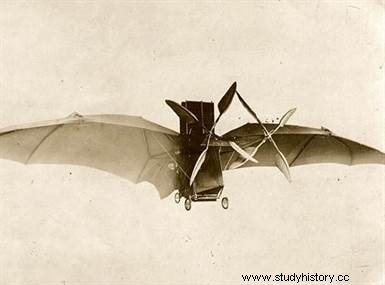 The invention of the first airplane is generally attributed to Clément Ader , French engineer and brilliant inventor. If he is considered one of the pioneers of aviation, he is far from being the only one to have contributed to the development of the plane, a machine which revolutionized the military art as much as transport civil. Alberto Santos Dumont, the Wright brothers or even Otto Lilienthal were thus among those who transformed in a few years a simple utopia into a breathtaking reality:man could finally defy nature and fly.
The invention of the first airplane is generally attributed to Clément Ader , French engineer and brilliant inventor. If he is considered one of the pioneers of aviation, he is far from being the only one to have contributed to the development of the plane, a machine which revolutionized the military art as much as transport civil. Alberto Santos Dumont, the Wright brothers or even Otto Lilienthal were thus among those who transformed in a few years a simple utopia into a breathtaking reality:man could finally defy nature and fly.
The first plane, the origins of aeronautics
Observing the flight of birds, Leonardo da Vinci imagined the concept of the propeller, the parachute and the Helicopter and glider as early as the 16th century. The only driving force usable at the time being that of the muscles of man, these brilliant ideas will remain for a long time in the state of concept. Moreover, the Italian physiologist and physicist Giovanni Borelli concluded in 1680 that man was incapable of flying on his own:the inventors then turned to the design of machines lighter than air, like the Montgolfier brothers who flew the first hot air balloon in 1783.
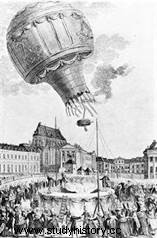 The history of aviation experienced a turning point at the beginning of the 19th century, thanks to the progress made in the fields of construction and mechanics. Plans were again made to fly heavier-than-air machines, replacing the muscular strength of man with the driving force of a machine. Many experiments were then carried out in an attempt to perfect the flying machines, and thus achieve a better understanding of the flight of a machine. It was in the last years of the 16th century that the Briton George Cayley set out the principles of what would become aviation. Research, very active, led to the first flight of a model steam airplane around 1840.
The history of aviation experienced a turning point at the beginning of the 19th century, thanks to the progress made in the fields of construction and mechanics. Plans were again made to fly heavier-than-air machines, replacing the muscular strength of man with the driving force of a machine. Many experiments were then carried out in an attempt to perfect the flying machines, and thus achieve a better understanding of the flight of a machine. It was in the last years of the 16th century that the Briton George Cayley set out the principles of what would become aviation. Research, very active, led to the first flight of a model steam airplane around 1840.
Who invented the airplane?
Clement Ader's work on systems allowing men to fly began during the War of 1870 , during which he tried to develop for the army kites capable of making a man fly. In vain. His collaboration with the military did not stop however:Ader found there a source of financing and support for his research, complementary to his own fortune which he owed to the many inventions patented by him. His efforts eventually paid off:between 1890 and 1897 he produced three prototypes:l'Éole (the Plane), the Zephyr (Ader Avion II) and l’Aquilon (Ader Airplane III). From 50 meters for the first test, the flight distance was increased to 300 meters with Plane 3, before a military committee which did not miss a beat. Very observant of nature, Ader draws inspiration from bat wings for his sails and even incorporates mechanisms capable of modifying their structure once in flight.
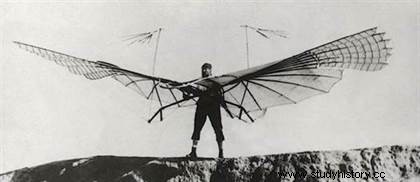 At the same time a certain Otto Lilienthal manages to develop a glider capable of flying 400 meters once launched from a hill 20 meters high. His prototypes were made from cotton-lined bamboo ribs.
At the same time a certain Otto Lilienthal manages to develop a glider capable of flying 400 meters once launched from a hill 20 meters high. His prototypes were made from cotton-lined bamboo ribs.
Finally, let's not forget the prowessof Alberto Santos-Dumont, Brazilian aviation pioneer, who built a number of balloons and dirigibles aboard which he flew, as well as an aircraft, the 14 Bis, aboard which he homologated the first world aviation record on October 23, 1906.
The Wright Brothers invent the first powered airplanes
If Ader was indeed the inventor of the airplane, as we have just seen, it was the brothers Orville and Wilbur Wright who succeeded, after multiple prototypes of gliders, in achieving the first powered and controlled flight of an aircraft (heavier than air), on December 17, 1903 at Kitty Hawk (North Carolina). The event nevertheless passes almost unnoticed in the columns of the newspapers of the time.
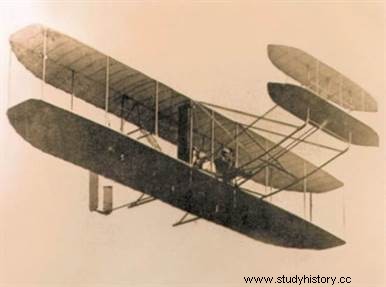 They were also the first to have correctly analyzed the mechanics necessary for the turn in flight and to have developed the trajectory control. From 1905, their planes thus made it possible to carry out stable, long-lasting flights with perfect control of turns. Their models are called Flyer I, II then III :object of desire of the American army, they will inspire most biplanes engaged in the First World War.
They were also the first to have correctly analyzed the mechanics necessary for the turn in flight and to have developed the trajectory control. From 1905, their planes thus made it possible to carry out stable, long-lasting flights with perfect control of turns. Their models are called Flyer I, II then III :object of desire of the American army, they will inspire most biplanes engaged in the First World War.
Military aviation...
Following the feat of the Wright brothers, Europeans were quick to react, and, carried by a strong current of opinion as well as by the promise of financial rewards granted by patrons, industrialists and companies promoting aerial navigation, the aviators of the Old Continent accumulated technical advances and records. On the eve of the Great War, they crossed the English Channel and the Mediterranean, criss-crossing the European continent as well as part of Africa. At the same time, the foundations of an aviation industry were laid in different countries.
In the absence of real civilian outlets, this new branch devotes most of its activity to the military field. In a Europe in the midst of an arms race, the arsenals number several hundred airplanes. The idea of using the plane for military purposes was imposed from the start, but the 1914-1918 war gave it the decisive impetus. The airplane becomes not only a tool for observation, but also for combat (hunting and bombing). This conflict was marked by considerable industrial production (50,000 aircraft in France, 40,000 in England and as many in Germany).
...to the first airlines
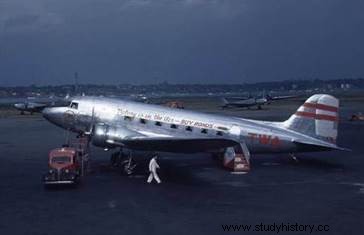 At the end of hostilities, aviation naturally moved towards the opening of airlines that promised it a bright future. The North and South Atlantic and the Pacific were crossed, the two poles were conquered, all the continents were explored, and the first circumnavigation of the globe took place in 1924. Passenger transport companies, subsidized by the States, were born:Lufthansa (Germany), Aeroflot (Soviet Union), Air France (France), Imperial Airways (UK), KLM (Netherlands), Pan American World Airways, Eastern Air Lines, TWA and United Airlines (USA). In 1933, Air France operated a network of 38,000 km, and in 1935 Aeroflot transported 100,000 people. In 1939, commercial aviation extended its networks over a large part of the planet, the first connections began over the Atlantic and airmail lines operated regularly.
At the end of hostilities, aviation naturally moved towards the opening of airlines that promised it a bright future. The North and South Atlantic and the Pacific were crossed, the two poles were conquered, all the continents were explored, and the first circumnavigation of the globe took place in 1924. Passenger transport companies, subsidized by the States, were born:Lufthansa (Germany), Aeroflot (Soviet Union), Air France (France), Imperial Airways (UK), KLM (Netherlands), Pan American World Airways, Eastern Air Lines, TWA and United Airlines (USA). In 1933, Air France operated a network of 38,000 km, and in 1935 Aeroflot transported 100,000 people. In 1939, commercial aviation extended its networks over a large part of the planet, the first connections began over the Atlantic and airmail lines operated regularly.
The Second World War amplified the role of the aircraft in military campaigns. The strategy is fundamentally and definitively disrupted. The air force accompanies armored and mechanized forces, supporting them with its fire and fighting to wrest control of the skies from the enemy. The bombers, on the other hand, are busy crushing the war industry of Japan and Germany, and undermining the morale of their populations. The climax is reached with the atomic attacks on Hiroshima and Nagasaki. At the same time, thanks to the aircraft carrier, the practice of warfare at sea is changing. The battleship, hitherto the backbone of the surface fleets, is dethroned. Finally, major technological advances such as the invention of radar, jet propulsion and electronics are changing warfare in the air.
The democratization of air transport
Until the Second World War, air transport was reserved for the most privileged classes. But the progress made after 1945 led to unprecedented growth. The jet-powered commercial aircraft takes over the conventional machines. The initiative first belonged to the British, who produced the first device of this category, the Cornet; but, this program having failed, the Americans took the advantage towards the end of the 1950s, with the Boeing 707 and the Douglas DC-8. This domination was called into question from the 1970s, with the emergence of a powerful European aeronautical industry, which produced a remarkable line of commercial aircraft, under the leadership of Airbus, a European consortium. At present, China is among the future first-class producers.
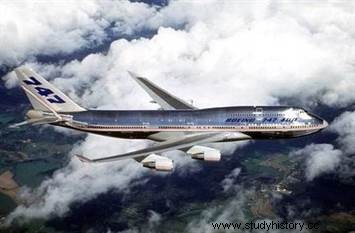 The dream of a supersonic aircraft (Concorde, Tupolev Tu-144) capable of transporting a small number of passengers seems to have faded in the face of the construction of jumbo jets capable of carrying more than 500 people. This fundamental technical choice has allowed an extraordinary democratization of air transport. With the Boeing 747, 757, 767 and 777, the Douglas DC-10, the Airbus A320, A330, A340, A350 and the giant A380, mass transport has entered the mainstream. From 156 million passengers in the mid-1960s, traffic rose to 3.3 billion in 2014. The needs of the world fleet are estimated at more than 29,000 aircraft by 2030, where 36,650 machines should be in service .
The dream of a supersonic aircraft (Concorde, Tupolev Tu-144) capable of transporting a small number of passengers seems to have faded in the face of the construction of jumbo jets capable of carrying more than 500 people. This fundamental technical choice has allowed an extraordinary democratization of air transport. With the Boeing 747, 757, 767 and 777, the Douglas DC-10, the Airbus A320, A330, A340, A350 and the giant A380, mass transport has entered the mainstream. From 156 million passengers in the mid-1960s, traffic rose to 3.3 billion in 2014. The needs of the world fleet are estimated at more than 29,000 aircraft by 2030, where 36,650 machines should be in service .
Some other key dates in aviation history
- 1909 - French aviator Louis Blériot crosses the English Channel from Calais to Dover aboard his "Blériot XI"
- 1911 - Roland Garros breaks the world altitude record:3910 meters (September 4)
- 1914 - On October 5, German Lieutenant Von Zangen's Aviatik was shot down, near Reims, by Sergeant Frantz and Corporal Quénault's Voisin III:this was the first aerial combat
- 1927 - May 21, Lindbergh crosses the Atlantic
- 1930 - First transatlantic postal link May 12, by French aviator Jean Mermoz
To go further
- Stephen Woolford's History of Aviation. 2009.
- The History of Aviation for Dummies by Philippe Benhamou. Editions First, 2010.
